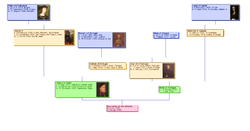
Pedigree collapse, sometimes known by the German term Ahnenschwund ("loss of lineage") is a term used in genealogy to describe how the reproduction between two individuals who knowingly (or unknowingly) share an ancestor causes the family tree of their offspring to be smaller than it would be in a different situation.
Normally, each person in a family tree has different ancestors, like their parents, grandparents, and great-grandparents. But sometimes, two people who are related (like cousins) have children together. When that happens, their family tree gets a bit smaller because some of the same ancestors appear more than once. This is called pedigree collapse!
The biological impact of this is DNA will be reintroduced from multiple family lines, thus complicating at first the assumptions which ancestors who's segments are passed down to matches. Populations from places with few ancestors outside of a geographical region will have symptoms of endogamy. Endogamous populations have high degree of pedigree collapse. All humans have pedigree collapse. a study by Ian J Heath in 2018[1] found that it is not uncommon to loose unique ancestors 4 generations back due to pedigree collapse. After approximately 10 generations, he calculated only 68 new ancestors will be added to the pedigree of a person.
See also
Explore more about pedigree collapse
- Pedigree collapse at the International Society of Genetic Genealogy Wiki
- How many ancestors do you have? by Stephen Lewis, The Wild Peak, March 4, 2012
References
- ↑ How many ancestors does a Briton have? Researchgate.net